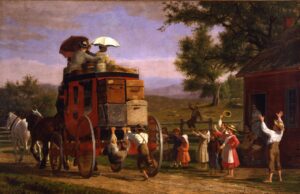SHELBURNE, Vt. (May 13, 2020)–American Stories, a new online exhibition that examines the American experience as seen through the collections of Shelburne Museum, launches Thursday, Shelburne Museum Director Thomas Denenberg announced.
Drawing inspiration from Shelburne’s vast holdings of American art, architecture and material culture, American Stories is an exhibition in four parts—People, Travel, Home and Community. Part One: People is set to launch on May 14, with subsequent parts scheduled to be posted every other week on May 28, June 11 and June 25.
“American Stories offers a window onto periods in the nation’s history as interpreted through some of Shelburne’s most familiar and beloved objects ranging from 19th-century portraits of William and Nancy Lawson by William Matthew Prior, hooked rugs by contemporary artist Patty Yoder and even the 1906 steamboat Ticonderoga,” Denenberg said. “This exhibition highlights the breadth of the museum’s collections and the artists and makers who contributed to a uniquely American narrative story through their art.”
The exhibition is accompanied by interactive experiences including recorded talks from curators, preservation and conservation insights and educational activities.
“While represented in many forms, from paintings to textiles to a locomotive and steamship, American Stories reflects on the ingenuity, creativity and skill of artists and makers that offers a look back while also sending a hopeful message about the future,” said Associate Curator Katie Wood Kirchhoff, who organized the exhibition.
American Stories is the second exclusively online exhibition launched by the museum since temporarily closing due to the coronavirus pandemic. The first, Color, Pattern, Whimsy, & Scale, is an exploration of museum founder Electra Havemeyer Webb’s passion for American folk art and her collecting ethos as she assembled one of the earliest and largest collections that would become the foundation for the museum.
Forthcoming exhibitions include Painting at Home with Grandma Moses, a sampling of works by Anna Mary Robertson (“Grandma”) Moses in partnership with Bennington Museum, Bennington, Vermont, that focus on the artist’s landscapes of the imagination for the modern era that stir feelings of nostalgia for decades past.
Generous support for this exhibition is provided by The Donna and Marvin Schwartz Foundation and the Barnstormers at Shelburne Museum.
About Shelburne Museum: Founded in 1947 by pioneering folk art collector Electra Havemeyer Webb (1888–1960), Shelburne Museum in Shelburne, Vermont, is the largest art and history museum in northern New England and Vermont’s foremost public resource for visual art and material culture. The Museum’s 45-acre campus is comprised of 39 buildings including the Pizzagalli Center for Art and Education and Webb Gallery featuring important American paintings by Andrew Wyeth, Winslow Homer, Grandma Moses, John Singleton Copley, and many more. For more information, please visit shelburnemuseum.org.
IMAGE CAPTIONS:

Enoch Wood Perry (American, 1831-1915) The Pemigewasset Coach, 1899. Oil on canvas, 42 5/8 x 66 5/8 in. Collection of Shelburne Museum. In Perry’s painting, viewers are encouraged to conjure and celebrate a way of American life that had all but disappeared by the close of the 19th century. The Pemigewasset carried New Hampshire summer travelers between Concord and the Pemigewasset House in Plymouth. By the 1890s, most travelers would have journeyed by train, and coaches like this one were an anachronistic nod to a simpler, less industrialized past. Populations in small communities like Concord and Plymouth were rapidly dwindling as young people relocated to urban centers in search of factory jobs. Paintings like this one appealed to consumers in cities who yearned for the past, whether real or imagined.

William Matthew Prior (American, 1806-73), Mrs. Nancy Lawson, 1843. Oil on canvas, 30 1/8 x 25 in. Collection of Shelburne Museum. This portrait of Nancy Lawson (1810–1854) is one of a pair of portraits regarded to be Prior’s masterpieces and icons of American folk art. Prior signed the portrait with his name and the name of the sitter on the front of the canvas—a courageous, and potentially dangerous, action for both artist and subject. Although Boston was the epicenter of abolitionism in New England, racism still existed at all levels of society; the signature is both an artistic statement and an expression of the painter’s moral values.
###

